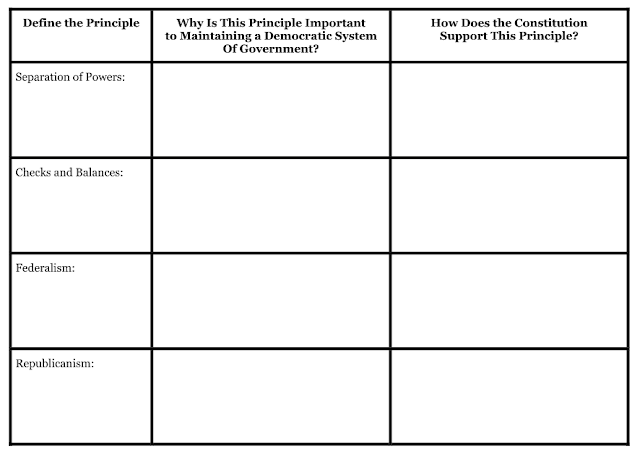DO NOW: in your composition book, copy and annotate the lesson objective.
________________________________________________________________________________
________________________________________________________________________________
Objective: SWBAT analyze and describe the role of the executive and judicial branches of the federal government.
Standard: CA.8.3.6 - Describe the basic law-making process and how the Constitution provides numerous opportunities for citizens to participate in the political process and to monitor and influence government (e.g., function of elections, political parties, interest groups).
AGENDA / ESSENTIAL QUESTIONS
- S1: Features of the Constitution
- How is the Constitution organized?
- S2: The Legislative Branch
- What are the powers of the legislature?
- S3: The Legislative Process
- What is the basic lawmaking process in the federal government?
- S4. Influencing Legislation
- How does the Constitution provide opportunities for citizens to participate in the political process?
- S5. The Executive Branch (Article II)
- What are the powers of the president?
- S6. The Judicial Branch (Article III)
- What are the powers of the judiciary?
- S7. Democratic Principles
- What democratic principles are reflected in the Constitution?
- S8. How much is too much?
- How does the Constitution limit the powers of the government?
- S9. A More Perfect Union?
- What is federalism?
- S10. Federal Supremacy
- How does the Constitution balance power between the federal government and the states?
- How is the Constitution organized?
- What are the powers of the legislature?
- What is the basic lawmaking process in the federal government?
- How does the Constitution provide opportunities for citizens to participate in the political process?
- What are the powers of the president?
- What are the powers of the judiciary?
- What democratic principles are reflected in the Constitution?
- How does the Constitution limit the powers of the government?
- What is federalism?
- How does the Constitution balance power between the federal government and the states?
_________________________________________________________________________________
CNN 10
S1: Features of the Constitution
How is the Constitution organized? (p133)
- video: The Preamble (1:30)
- small groups:
- read aloud and annotate S1
- respond to Focus Question 1
- whole class:
- share out Focus Question
- A More Perfect Union [Comparison Chart]:
_________________________________________________________________________________
S2: The Legislative Branch
What are the powers of the legislature? (p133)
- video: How a Law is Made (2:00)
- small groups:
- read aloud and annotate S2
- respond to Focus Question 2
- whole class:
- share out Focus Question
- A More Perfect Union [Comparison Chart]:
_________________________________________________________________________________
S3: The Legislative Process
What is the basic lawmaking process in the federal government? (p133)
- video: Amending the Constitution (2:15)
- small groups:
- read aloud and annotate S3
- respond to Focus Question 3
- whole class:
- share out Focus Question
- A More Perfect Union [Comparison Chart]:
_________________________________________________________________________________
S4. Influencing Legislation
How does the Constitution provide opportunities for citizens to participate in the political process? (p133)
- video: Making a Law (2:15)
- small groups:
- read aloud and annotate S1
- respond to Focus Question 1
- whole class:
- share out Focus Question
- A More Perfect Union [Comparison Chart]:
_________________________________________________________________________________
S5: The Executive Branch (Article II)
What are the powers of the president?
- video: Who Works for the President? (3:30)
- small groups:
- read aloud and annotate S5
- respond to Focus Question 5
- whole class:
- share out Focus Question
- A More Perfect Union [Comparison Chart]:
________________________________________________________________________________
S6. The Judicial Branch (Article III)
What are the powers of the judiciary? (p133)
- video: Supreme Court Justices (1:40)
- small groups:
- read aloud and annotate S6
- respond to Focus Question 6
- whole class:
- share out Focus Question
- A More Perfect Union [Comparison Chart]:
_________________________________________________________________________________
S7. Democratic Principles
What democratic principles are reflected in the Constitution?
- video: America's Roots (3:30)
- small groups:
- read aloud and annotate S7
- respond to Focus Question 7
- whole class:
- share out Focus Question
- A More Perfect Union [Comparison Chart]:
_________________________________________________________________________________S8. How much is too much?
How does the Constitution limit the powers of the government?
- video: Turning Points - Separation of Powers (5:55)
- small groups:
- read aloud and annotate S8
- respond to Focus Question 8
- whole class:
- share out Focus Question
- A More Perfect Union [Comparison Chart]:
_________________________________________________________________________________
S9. A More Perfect Union?
What is federalism?

- video: Montesquieu's Ideas about Government(4:35)
- small groups:
- read aloud and annotate S7
- respond to Focus Question 7
- whole class:
- share out Focus Question
- A More Perfect Union [Comparison Chart]:
_________________________________________________________________________________





